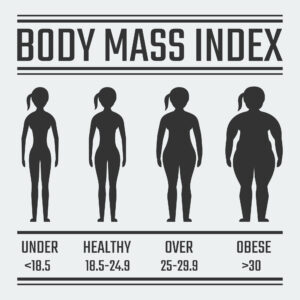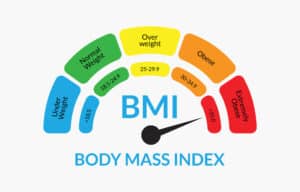
What Is Body Mass Index (BMI)?
What Is Body Mass Index (BMI)? It’s a scale is a widely used tool for assessing an individual’s weight status and overall health. It provides a numerical value that indicates whether a person is underweight, normal weight, overweight, or obese.
In this comprehensive blog post, we will delve into the world of BMI, exploring its history, limitations, and significance in health assessment. By the end of this article, you will have a thorough understanding of Body Mass Index and its role in maintaining a healthy lifestyle.
Key Takeaways
- Body Mass Index is a measure of body fat based on height and weight.
- BMI has limitations and should be considered alongside other factors.
- Body Mass Index categories indicate different levels of health risks.
- Body composition plays a role in BMI and overall health.
- Improving Body Mass Index can improve overall health, but it’s important to consider other factors as well.
Understanding the Basics: What Is Body Mass Index (BMI)?
BMI is defined as an individual’s weight in pounds divided by the square of their height in inches. This calculation provides a numerical value that is then categorized into different weight status categories. The importance of BMI lies in its ability to assess an individual’s health based on their weight and height. It serves as an initial screening tool to identify potential health risks associated with weight status.
In medical settings, BMI is commonly used by healthcare professionals to assess patients’ weight status and determine if further evaluation or intervention is necessary. It helps healthcare providers identify individuals who may be at risk for various health conditions such as cardiovascular disease, diabetes, and certain types of cancer. By understanding the basics of Body Mass Index, we can better comprehend its significance in maintaining optimal health.
The History of BMI and Its Limitations
The concept of BMI was first introduced by Belgian mathematician Adolphe Quetelet in the early 19th century. Quetelet developed the Quetelet Index, which later became known as the Body Mass Index. Initially, it was intended as a statistical tool to study population characteristics rather than an individual health assessment tool.
Despite its widespread use today, BMI has faced criticism for its limitations as a measure of health. One major limitation is that it does not take into account factors such as muscle mass and body composition. For example, athletes with high muscle mass may have a higher BMI, even though they are not overweight or unhealthy. Additionally, BMI fails to consider differences in body fat distribution, which can impact health risks.
Alternative methods of assessing health have emerged to address these limitations. These include measures such as waist circumference, waist-to-hip ratio, and body fat percentage. These alternative methods provide a more comprehensive view of an individual’s health beyond just their weight and height.
How Body Mass Index is Calculated
We offer a free BMI Calculator. Just click over and enter in your weight and height to get your Body Mass Index.
| Measurement | Formula |
|---|---|
| Weight (in pounds) | W |
| Height (in inches) | H |
| BMI Formula | BMI = W / (H x H) |
| BMI Categories |
|
BMI is calculated using a simple formula: weight in pounds divided by the square of height in inches. The resulting number is then categorized into different weight status categories. For example, a BMI below 18.5 is considered underweight, while a BMI between 18.5 and 24.9 is considered normal weight.
To illustrate the calculation, let’s consider an example. Suppose an individual weighs 70 pounds and has a height of 1.75 inches. To calculate their BMI, we divide 70 by (1.75 x 1.75), which equals 22.86. This falls within the normal weight category according to the BMI scale.
It is important to note that while BMI provides a general indication of weight status, it does not take into account individual variations such as muscle mass or body composition. Therefore, it should be used as a starting point for health assessment rather than the sole determinant of one’s overall health.
The Different BMI Categories and What They Indicate

Body Mass Index (BMI)
The BMI scale categorizes individuals into different weight status categories: underweight, normal weight, overweight, and obese. These categories provide a general indication of an individual’s weight status and potential health risks associated with each category.
An individual with a BMI below 18.5 is considered underweight. This may indicate insufficient calorie intake or underlying health conditions such as malnutrition or eating disorders. On the other hand, a BMI between 18.5 and 24.9 falls within the normal weight category, indicating a healthy weight status.
BMI values between 25 and 29.9 are classified as overweight. This suggests an excess of body weight, which may increase the risk of developing various health conditions such as high blood pressure, heart disease, and type 2 diabetes. Finally, a BMI of 30 or higher is classified as obese, indicating a significantly increased risk of obesity-related health problems.
The Relationship Between Body Mass Index and Health Risks
Numerous studies have established a strong link between high BMI and an increased risk of various health conditions. Obesity, in particular, has been associated with a higher likelihood of developing chronic diseases such as cardiovascular disease, type 2 diabetes, certain types of cancer, and musculoskeletal disorders.
Excess body weight places additional stress on the cardiovascular system, leading to elevated blood pressure and an increased risk of heart disease. It also disrupts insulin regulation in the body, contributing to the development of insulin resistance and type 2 diabetes. Furthermore, obesity is a known risk factor for certain types of cancer, including breast, colon, and kidney cancer.
Maintaining a healthy BMI is crucial for overall health and reducing the risk of these chronic diseases. By understanding the relationship between BMI and health risks, individuals can take proactive steps to improve their weight status and overall well-being.
The Debate Over BMI as a Measure of Health
Despite its widespread use, BMI has faced criticism as a one-size-fits-all measure of health. One major criticism is that it fails to account for individual variations in body composition. For example, athletes with high muscle mass may have a higher BMI due to their increased weight from muscle rather than fat.
Additionally, BMI does not consider differences in body fat distribution. Accumulation of fat around the waist (central obesity) has been shown to be more strongly associated with health risks than overall body fat percentage. Therefore, relying solely on BMI may overlook individuals with central obesity who are at a higher risk of developing chronic diseases.
Arguments for using BMI as a health assessment tool include its simplicity and cost-effectiveness. BMI can be easily calculated using readily available height and weight measurements, making it accessible to a wide range of individuals and healthcare providers. It also serves as a useful initial screening tool to identify individuals who may require further evaluation or intervention.
The Importance of Considering Other Factors Beyond Body Mass Index
While BMI provides valuable information about weight status, it is essential to consider other factors that contribute to overall health. Factors such as physical activity level, diet quality, stress levels, sleep patterns, and genetic predisposition all play a role in an individual’s well-being.
A holistic approach to health assessment takes into account these additional factors beyond BM
For example, an individual with a normal BMI but a sedentary lifestyle and poor dietary habits may still be at risk for developing chronic diseases. On the other hand, someone with a higher BMI but an active lifestyle and healthy eating habits may have a lower risk of health problems.
By considering these additional factors, individuals can gain a more comprehensive understanding of their overall health and make informed decisions about lifestyle changes that can improve their well-being.
The Role of Body Composition in BMI
Body composition refers to the proportion of fat, muscle, bone, and other tissues in the body. It plays a significant role in determining an individual’s weight status and overall health. However, BMI alone does not account for differences in body composition.
Muscle is denser than fat, meaning that it weighs more per unit of volume. Therefore, individuals with higher muscle mass may have a higher BMI due to their increased weight from muscle rather than fat. This can lead to an overestimation of body fat and potentially misclassify individuals as overweight or obese.
Considering body composition alongside BMI provides a more accurate assessment of an individual’s weight status and health risks. Methods such as body fat percentage measurements or waist-to-hip ratio can help determine the proportion of fat versus muscle in the body, providing a more comprehensive view of an individual’s health.
How to Interpret Your Body Mass Index Results

Body Mass Index Chart
Interpreting your BMI results involves understanding what your BMI number means in the context of your overall health. As mentioned earlier, BMI falls into different weight status categories: underweight, normal weight, overweight, and obese. However, it is important to remember that BMI is just one piece of the puzzle when it comes to assessing health.
If your Body Mass Index falls within the normal weight range, it indicates a healthy weight status. However, it is still essential to consider other factors such as physical activity level, diet quality, and overall well-being. On the other hand, if your BMI falls outside the normal range, it may be an indication that further evaluation or lifestyle changes are necessary.
It is crucial to consult with a healthcare professional to interpret your Body Mass Index results accurately. They can provide personalized guidance based on your individual circumstances and help you develop a plan to improve your weight status and overall health.
Tips for Improving Your BMI and Overall Health
Maintaining a healthy BMI and overall health requires a combination of lifestyle changes and professional guidance. Here are some tips to help you improve your BMI and well-being:
- Adopt a balanced diet: Focus on consuming nutrient-dense foods such as fruits, vegetables, whole grains, lean proteins, and healthy fats. Limit processed foods, sugary beverages, and excessive calorie intake.
- Engage in regular physical activity: Aim for at least 150 minutes of moderate-intensity aerobic activity or 75 minutes of vigorous-intensity aerobic activity per week. Incorporate strength training exercises to build muscle mass.
- Prioritize sleep: Aim for 7-9 hours of quality sleep each night to support overall health and weight management.
- Manage stress: Practice stress management techniques such as meditation, deep breathing exercises, or engaging in hobbies to reduce stress levels.
- Seek professional guidance: Consult with a healthcare professional or registered dietitian to develop a personalized plan based on your individual needs and goals.
Remember, improving your BMI and overall health is a journey that requires patience, consistency, and a holistic approach.
The Future of Body Mass Index and Health Assessment
As research in the field of health assessment continues to evolve, advancements beyond BMI are being explored. Scientists are investigating alternative methods that consider factors such as body composition, waist circumference, and genetic markers to provide a more accurate assessment of an individual’s health risks.
Technological advancements, such as wearable devices and mobile applications, are also being developed to track various health parameters beyond just weight and height. These innovations have the potential to revolutionize health assessment by providing real-time data and personalized recommendations for individuals seeking to improve their well-being.
Ongoing research and development in the field of health assessment are crucial for refining existing tools like BMI and exploring new approaches to better understand the complex relationship between weight status and overall health.
FAQs
What is What Is Body Mass Index (BMI)?
BMI stands for Body Mass Index, which is a measure of body fat based on height and weight.
How is Body Mass Index calculated?
BMI is calculated by dividing a person’s weight in pounds by their height in inches squared.
What is a healthy BMI range?
A healthy BMI range is typically considered to be between 18.5 and 24.9.
Is Body Mass Index an accurate measure of health?
BMI is not always an accurate measure of health, as it does not take into account factors such as muscle mass or body composition. However, it can be a useful tool for identifying potential health risks.
Can BMI be used for everyone?
Body Mass Index is generally not recommended for use in children, pregnant women, or athletes, as it may not accurately reflect their body composition or health status.
What are some limitations of using BMI?
Some limitations of using Body Mass Index include its inability to differentiate between muscle mass and fat mass, its lack of consideration for body composition, and its potential to misclassify individuals as overweight or obese.
Conclusion
In conclusion, BMI serves as a valuable tool for assessing weight status and potential health risks associated with it. While it has its limitations, BMI provides a starting point for individuals to evaluate their overall health. By considering other factors such as body composition, physical activity level, diet quality, and stress management, individuals can gain a more comprehensive understanding of their well-being.
Maintaining a healthy BMI is essential for reducing the risk of chronic diseases and promoting overall health. However, it is important to remember that BMI is just one piece of the puzzle when it comes to assessing health. A holistic approach that considers various factors beyond BMI is necessary for a comprehensive evaluation of an individual’s well-being.
As research continues to advance in the field of health assessment, we can expect to see improvements in existing tools like BMI and the emergence of new methods that provide a more accurate assessment of health risks. By staying informed and seeking professional guidance, individuals can take proactive steps towards improving their BMI and overall health.






